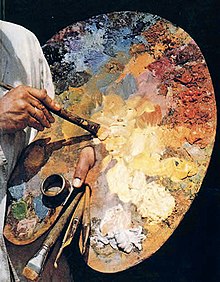Palette (painting)
In painting, a palette is a board with a thumbhole made of today's mostly polished wood, more rarely of porcelain or metal, for mixing colors when painting. Painters use pallets mainly when painting with oil paints.
The palette is sometimes more accurately referred to as a painter's palette, paint palette, color palette, or mixing palette. The term palette derives via French palette "small round board" from Latin pala, meaning "spade" or "shovel".
The oldest evidence of the palette are the reproductions of the still hand-mirror-shaped device in the miniatures of an illuminated manuscript of the biographical collection De mulieribus claris by Giovanni Boccaccio from 1374. A manual from 1795 describes the handling of the palette thus: The painter thus carries with him on this board the colours which he uses. Above are the simple colours, below the mixed colours". Palettes of some famous painters are kept in museums.
The palette in its characteristically asymmetrical form is often used as a symbol or attribute, it then stands as a symbol of painting or as a signifier of the "pictura", the personification of painting.
· 
Georg Friedrich Kersting: Caspar David Friedrich in his studio with palette
· 
Palette painted with miniatures by various painters of the 19th century
· 
Back cover

Mixing the oil paints on a palette

Oil paint palette
Search within the encyclopedia